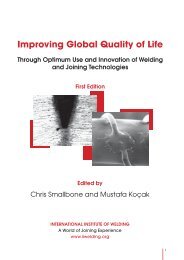The Comparison of Microstructure and Mechanical Properties of
The Comparison of Microstructure and Mechanical Properties of
The Comparison of Microstructure and Mechanical Properties of
Create successful ePaper yourself
Turn your PDF publications into a flip-book with our unique Google optimized e-Paper software.
Different FCWs’ hardnesses were performed on the<br />
samples with a Vickers indenter with a load 300 g. force.<br />
Figure 11 shows the hardness values <strong>of</strong> FCWs. As<br />
shown in figure, E wire has the highest hardness with<br />
306 Hv among the all FCWs.<br />
In this study, FCWs in rutile, basic <strong>and</strong> metal-cored<br />
types were used to produce butt-joints <strong>and</strong> the welds<br />
were investigated in terms <strong>of</strong> microstructural features<br />
<strong>and</strong> mechanical properties to find out the microstructureproperty<br />
relationships. Commercially available FCWs<br />
(from different manufacturing companies <strong>and</strong> countries)<br />
were used <strong>and</strong> their results are compared with prototype<br />
wires which are currently in development.<br />
Microstructural features were examined using optical<br />
micrograpical examinations while Charpy-V toughness<br />
was obtained both at RT <strong>and</strong> -20ºC temperatures. Tensile<br />
tests were conducted at RT.<br />
Following conclusions could be made for the results<br />
obtained:<br />
For all FCWs, no major weldability problem<br />
was observed <strong>and</strong> all weld joints were produced<br />
without any weld defects.<br />
Tensile strength values <strong>of</strong> all weld metals were<br />
above 510 MPa while Charpy-V toughness<br />
values at RT were above 80 Joule except FCwire<br />
K (46 Joule). This rutile K wire has also<br />
produced lowest impact toughness value (14<br />
Joule) at -20ºC. <strong>The</strong> E wire has produced 22<br />
Joule Charpy impact energy at -20ºC while it<br />
has exhibited highest hardness values <strong>of</strong> 306.<br />
<strong>The</strong> reason <strong>of</strong> low impact toughness values<br />
needs to be clarified. Hence, oxygen levels are<br />
currently examined <strong>and</strong> also new welds are<br />
being made for new sets <strong>of</strong> tests.<br />
Figure 11. Hardness values <strong>of</strong> FCWs<br />
It is evident from the data presented in Table 2, Nickel<br />
content are obtained for weld metal is high in E wire<br />
since higher nickel content supports the highest hardness<br />
values. Nickel content <strong>of</strong> E wire is about % 0.46, G, K,<br />
S, B <strong>and</strong> M wire’s nickel contents are 0.009, 0.057,<br />
0.192, 0.04 <strong>and</strong> 0.007 respectively. As reported by Kang<br />
et al. [9] for a low-Mn composition, Ni addition<br />
increases hardness without sacrificing impact toughness<br />
much whereas for a high Mn composition (1.6 % Mn),<br />
Ni deteriorates the impact toughness seriously.<br />
Furthermore, E wire has fine grain size. This property<br />
makes the wire harder. <strong>The</strong> lowest hardness value is G<br />
wire with 255 Hv <strong>and</strong> K wire’s hardness value is also<br />
low compared to others. Coarse grain <strong>and</strong> inclusions in<br />
weld metal keep the G <strong>and</strong> K wire’s hardness low. B <strong>and</strong><br />
M wire’s hardnesses were found approximately 270 Hv.<br />
5. Conclusions<br />
Weld Metal<br />
References<br />
<strong>The</strong> microstructure <strong>of</strong> the K wire has exhibited<br />
coarse grains while E wire assumed to have<br />
higher content <strong>and</strong> coarser non-metallic<br />
inclusions to cause lower impact toughness<br />
properties. <strong>The</strong> measurements <strong>of</strong> the oxygen<br />
levels <strong>and</strong> SEM investigations <strong>of</strong> the<br />
morphology <strong>of</strong> inclusions <strong>and</strong> fracture surfaces<br />
<strong>of</strong> the welds are in progress.<br />
[1] Pitrun M., Nolan D., Dunne D., “Diffusiable Hydrogen Content in<br />
Rutile Flux-cored Arc Welds as a Function <strong>of</strong> the Welding<br />
Parameters”, Welding In the World, Vol 48, n ½, 2004.<br />
[2] Posh G., Baumgartner S., Fiedler M., “GMA-Welding <strong>of</strong> creep<br />
resistant steels with flux cored wires (FCAW): perspectives <strong>and</strong><br />
limitations”, IIW International Conference on Advances in<br />
Welding <strong>and</strong> Allied Technologies, 2009.<br />
[3] Marie A., Zhang J. , “Self-Shielded Flux Cored Welding for Steel<br />
Constructions- Productivity <strong>and</strong> Performance”, IFWT 2006.<br />
[4] “Welding, Brazing <strong>and</strong> Soldering” ASM H<strong>and</strong>book, Vol 6, 1993.<br />
[5] Kannan T., Murugan N.,” Effect <strong>of</strong> flux cored arc welding process<br />
parameters on duplex stainless steel clad quality”, Journals <strong>of</strong><br />
Materials Processing Technology, 2006.<br />
[6] Liao M. T. <strong>and</strong> Chen W. J., “A <strong>Comparison</strong> <strong>of</strong> Gas Metal Arc<br />
Welding with Flux-Cored Wires <strong>and</strong> Solid Wires Using Shielding<br />
Gas”, <strong>The</strong> International Journal <strong>of</strong> Advanced Manufacturing<br />
Technology, 1999.<br />
[7] Varga T, Konkoly T, Straube H. “Investigation on microstructure,<br />
toughness, <strong>and</strong> defect tolerence <strong>of</strong> gas metal arc weld metal”., IIW<br />
Document, X-1205-90.<br />
[8] Mukhopadhyay S., Pal T.K., “Effect <strong>of</strong> shielding gas mixture on<br />
gas metal arc welding <strong>of</strong> HSLA steel using solid <strong>and</strong> flux-core<br />
wires”, <strong>The</strong> International Journal <strong>of</strong> Advanced Manufacturing<br />
Technology,29: 262-268, 2006.<br />
[9] Coronado J.J., Ceron C.,“Fracture mechanisms <strong>of</strong> CTOD samples<br />
<strong>of</strong> submerged <strong>and</strong> flux cored arc welding”, <strong>The</strong>oretical <strong>and</strong><br />
Applied Fracture Mechanics,2010.<br />
24
















